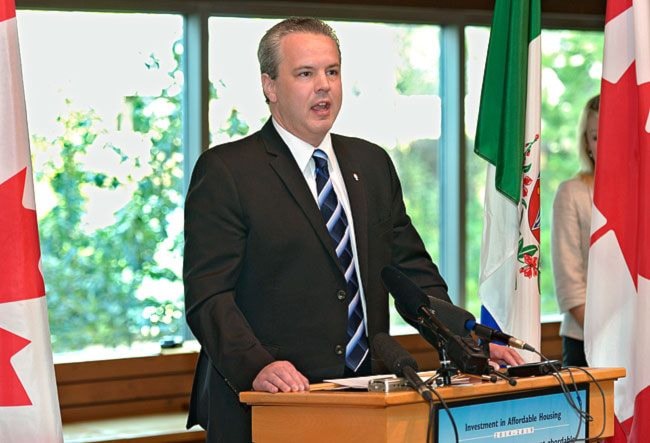Premier Darrell Pasloski says that Whitehorse city council’s unanimous decision to ask him to remove Brad Cathers from the housing file is “unusual” and “controversial,” and it is so.
Why, pray tell, would a Yukon Party minister be bounced from a portfolio simply because of a spectacular mess that he was instrumental in creating? If we actually started holding territorial politicians responsible for their performance, a terrifying precedent could be set. Nobody would be safe. The cheek to even suggest such a thing.
The whole imbroglio began this spring, when the Yukon Party decided it would help hard-working Yukoners who have trouble paying the rent by pouring the remaining federal affordable housing money into subsidized apartments. Builders would be required to keep rents below the median - currently $900 per month - for a decade.
Then, after developers had sunk considerable resources into preparing plans to bid on these funds, Cathers pulled the plug in the last minute, after hearing that landlords and realtors opposed the plans.
Cathers contends that new information had come to his attention. He asserts that the latest statistics suggest that affordable housing isn’t a big problem in Whitehorse, and that the market has self-corrected. He has also asserted that developers didn’t like one solution floated as a way of avoiding having well-off Yukoners take advantage of the subsidized units, which is to test the incomes of tenants.
On both of these counts, however, there’s evidence that Cathers is wrong.
Cathers told the legislature this week that rental vacancy rates in Whitehorse have swung from 1.5 per cent to 7.1 per cent. This is misleading. Until recently, Yukon’s housing statistics only included buildings with three or more units, while new numbers include smaller buildings as well. Cathers is mixing apples and oranges. (Yet, cheekily enough, he accuses the NDP’s Kate White of taking a “selective and uninformed view of statistics.)
Despite a growing number of vacant units, rents have continued to rise. So, if housing affordability was a problem before, it’s hard to see evidence that the market has solved the problem itself, as Cathers asserts.
What’s more, if there’s no problem, as he says, why do the city’s chamber of commerce and the territory’s chamber of mines both disagree? They say that businesses continue to have trouble recruiting and retaining workers in Whitehorse for lack of affordable digs.
It’s true that certain segments of the rental market - such as duplexes and condos - have higher vacancy rates. However, these units aren’t generally rented on the cheap. Meanwhile, few vacancies are to be found in the more affordable slice of the market, found in townhouses, detached homes, apartments and mobile homes.
One concern about the affordable housing scheme was that well-off Yukoners would end up taking advantage of the subsidized units. A solution would be to test the incomes of tenants. Cathers claims that developers would only agree to seeing one-third of their units income tested. Yet two developers have told the News they had no problem with that condition being applied to their whole projects.
A broader concern raised by Cathers is that the affordable units would have dramatically washed out rents, hurting mom-and-pop landlords. These fears seem overheated, given that the small number of units proposed is a drop in the bucket of the city’s existing rental stock.
Whether some downward pressure on rental prices is good or bad depends on where you stand, of course. Young working families and single mothers who rent would welcome this change. Landlords, not so much.
You could make the case that there’s nothing natural about the status quo. A few decades ago, the federal government was much more generous about supporting affordable housing, by creating incentives for developers to build things like apartment blocks. Nowadays, those incentives have disappeared, and the smart money builds condos, which can be sold for a relatively quick buck.
Cathers likes to boast about how his government has spent more than $100 million on housing initiatives since 2008. Yet it’s important to note this money hasn’t been spent on affordable housing. Instead, these funds have helped build housing for seniors, social assistance clients, women fleeing violence and residents with FASD. Providing supports for vulnerable residents is laudable, but it’s misleading to conflate social or transitional housing with affordable housing. They’re different things.
There are plenty of good ways for the Yukon government to put its remaining federal housing money to use, and it’s remarkable that, nearly a decade on, about $10 million is still sloshing around. It’s nice to hear the government’s most recent announcement it will expand the Salvation Army shelter, but that commitment was first made by the Yukon Party during the 2011 election. Had the government considered this project a priority, it would be well on its way to being built by now.
If there’s one takeaway from Cathers’s affordable housing debacle, it’s that the Yukon Party cares a lot more about the support of landlords than of hard-up renters. This would not be nearly so noticeable, of course, had he not committed to supporting the housing corporation’s plan to help hard-up renters, then reneged, as the Liberals’s Sandy Silver, who kicked off calls for Cathers’s removal, has noted.
In places where ministers are expected to do their jobs, this sort of thing really could be grounds for being shuffled off a portfolio. But where do city councillors think they live, anyhow?
